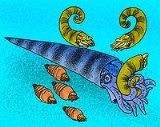
Piloceratidae
Encyclopedia
The Piloceratidae are a compressed, rapidly expanding, cyrtoconic brevicones with holochoanitic ventral siphuncle
s and simple endocones. Most likely evolved from Clitendoceras
, a narrow, slightly endogastric genus intermediate in form between straight shelled Proendoceras and the bulkier Piloceratidae. Found in shallow carbonate marine sediments of Demingian through the Cassinian age, (essentially Arenigian , = early Middle -Upper Canadian) .
Pilocerids split off from the Proterocameroceratidae
very shortly after their inception and are the first family which the proterocamerocerids gave rise to. With the exception of Humeoceras, found in the middle Silurian
, pilocerid genera are limited to the Lower Ordovician
(Canadian in North America).
The general shape of the pilocerid shell precludes an ambush predator lying in wait on the sea floor, or a stealthful hunter drifting through the water. Rather, they probably crawled over the sea floor, head down with the shell off the bottom, searching for prey.
Nothing is known of their soft part anatomy, other than what can be surmised from the fact they are cephalopods. They likely possessed tentacles of some sort, but were they numerous like those of modern Nautilus
, limited to eight or ten as with octopus or squid, or of some other arrangement.
Pilocerid genera include the strongly curved Piloceras, Bisonoceras with its hooked bison horn shape, nearly straight Allopiloceras, Dartonoceras, and internally complex Cassinoceras. Ecologically the Piloceratidae were replaced in the Middle Ordovician by the Cyrtendoceradae,which may have evolved early from the Endoceratidae rather than being direct pilocerid descendents.
Siphuncle
The siphuncle is a strand of tissue passing longitudinally through the shell of a cephalopod mollusk. Only cephalopods with chambered shells have siphuncles, such as the extinct ammonites and belemnites, and the living nautiluses, cuttlefish, and Spirula...
s and simple endocones. Most likely evolved from Clitendoceras
Clitendoceras
Clitendoceras is a member of the Endocerida from the Lower Ordovician with an elongate shell with a slight downward, endogastric, curvature and a siphuncle that lay along the ventral margin. Common for endocerids, the chambers are short and the septa close spaced with sutures sloping forward...
, a narrow, slightly endogastric genus intermediate in form between straight shelled Proendoceras and the bulkier Piloceratidae. Found in shallow carbonate marine sediments of Demingian through the Cassinian age, (essentially Arenigian , = early Middle -Upper Canadian) .
Pilocerids split off from the Proterocameroceratidae
Proterocameroceratidae
The Proterocameroceratidae were the first of the Endocerida. They began early in the Ordovician with Proendoceras or similar genus which had developed endocones, replacing the diaphragms of the ellesmerocerid ancestor....
very shortly after their inception and are the first family which the proterocamerocerids gave rise to. With the exception of Humeoceras, found in the middle Silurian
Silurian
The Silurian is a geologic period and system that extends from the end of the Ordovician Period, about 443.7 ± 1.5 Mya , to the beginning of the Devonian Period, about 416.0 ± 2.8 Mya . As with other geologic periods, the rock beds that define the period's start and end are well identified, but the...
, pilocerid genera are limited to the Lower Ordovician
Ordovician
The Ordovician is a geologic period and system, the second of six of the Paleozoic Era, and covers the time between 488.3±1.7 to 443.7±1.5 million years ago . It follows the Cambrian Period and is followed by the Silurian Period...
(Canadian in North America).
The general shape of the pilocerid shell precludes an ambush predator lying in wait on the sea floor, or a stealthful hunter drifting through the water. Rather, they probably crawled over the sea floor, head down with the shell off the bottom, searching for prey.
Nothing is known of their soft part anatomy, other than what can be surmised from the fact they are cephalopods. They likely possessed tentacles of some sort, but were they numerous like those of modern Nautilus
Nautilus
Nautilus is the common name of marine creatures of cephalopod family Nautilidae, the sole extant family of the superfamily Nautilaceae and of its smaller but near equal suborder, Nautilina. It comprises six living species in two genera, the type of which is the genus Nautilus...
, limited to eight or ten as with octopus or squid, or of some other arrangement.
Pilocerid genera include the strongly curved Piloceras, Bisonoceras with its hooked bison horn shape, nearly straight Allopiloceras, Dartonoceras, and internally complex Cassinoceras. Ecologically the Piloceratidae were replaced in the Middle Ordovician by the Cyrtendoceradae,which may have evolved early from the Endoceratidae rather than being direct pilocerid descendents.

